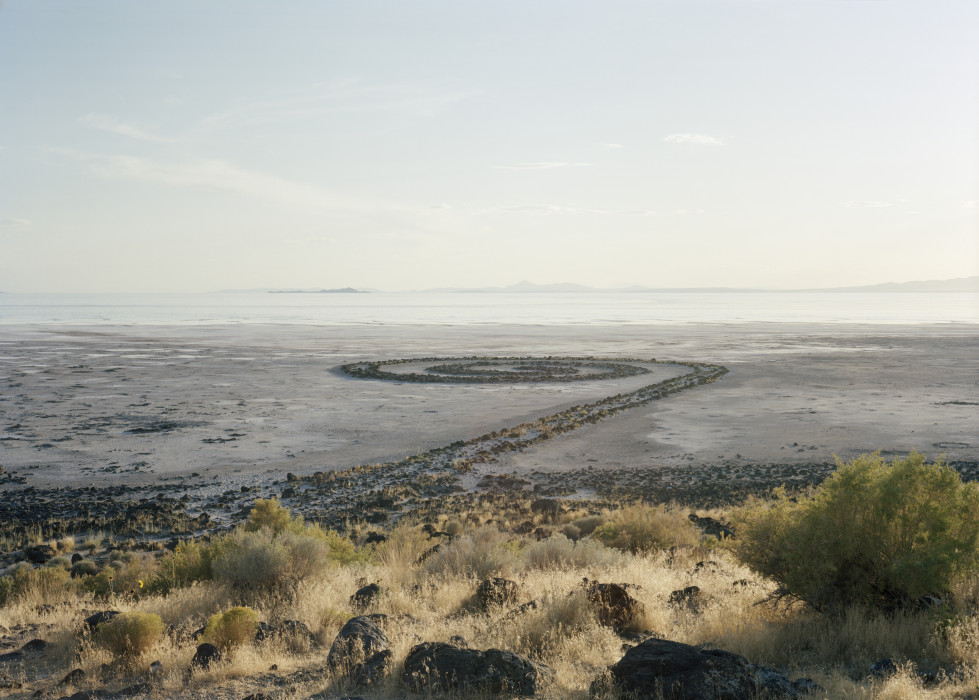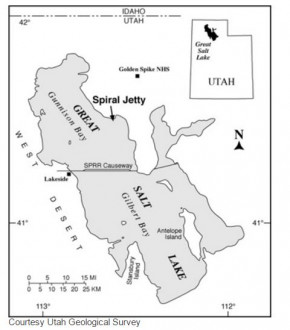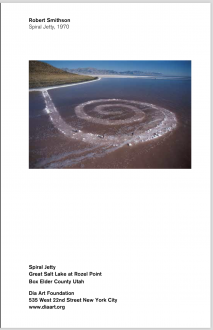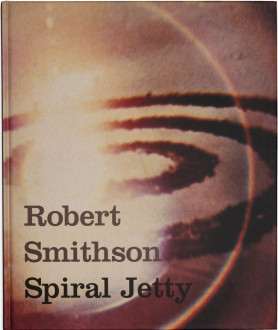Robert Smithson, Spiral Jetty
Great Salt Lake, Utah

Robert Smithson, Spiral Jetty (1970), 2019. © Holt/Smithson Foundation and Dia Art Foundation/Licensed by VAGA at Artists Rights Society (ARS), New York. Photo: Victoria Sambunaris
Overview
Robert Smithson’s Spiral Jetty, located at Rozel Point on the northeastern shore of Great Salt Lake in Utah, is one of the most remarkable examples of Land art. In 1970, assisted by a crew operating dump trucks, a tractor, and a front loader, Smithson displaced some 6,000 tons of black basalt rock and earth from the adjacent shore to form a coil 1,500 feet long and approximately 15 feet wide, winding counterclockwise into the lake. Created at a time when water levels were particularly low, Spiral Jetty was submerged in 1972. Droughts caused the lake to recede in 2002, and the sculpture has remained visible ever since.
“I like landscapes that suggest prehistory,”1 Smithson once observed. The site of Spiral Jetty was chosen by the artist for the lake’s unusual ecological and geological properties. The reddish coloration of the water, caused by the high presence of microbes, initially attracted Smithson to the north arm of the lake. The spiral shape alludes to the molecular lattice of the salt-crystal deposits found throughout the lake’s expanse, and in forming the work, he chose to use basalt boulders of hardened lava found along the peninsula, scattered remnants of the now extinct volcanos in the area.
The fractured landscape, fluctuating water levels, and the water’s salinity also speak of the artist’s preoccupation with the concept of entropy. Smithson envisioned an artwork in a state of constant transformation whose form is never fixed and undergoes decay from the moment of its creation. His thinking was equally shaped by his understanding of the third law of thermodynamics as well as a fascination in science fiction and popular science.
As a path for walking and looking, Spiral Jetty is a sculpture to be experienced. The act of traversing the earthwork is a prominent image in the eponymous film completed months after Smithson built the sculpture. Along with aerial shots of Spiral Jetty is a sequence of images of the artist running on the sculpture. Reaching the innermost point, Smithson gazes out at the spiral path, lake, and mountains. Spiral Jetty serves as a site from which to view the surroundings—the prehistoric environment that Smithson selected for it.
notes
1 Robert Smithson, “Conversation in Salt Lake City (1972),” in Robert Smithson: Collected Writings, ed. Jack Flam (Berkeley: University of California Press, 1996), p. 298.
Dia partners with Great Salt Lake Institute at Westminster College, Holt/Smithson Foundation, and the Utah Museum of Fine Arts at the University of Utah to further advocate for Spiral Jetty.
www.holtsmithsonfoundation.org
The Division of Forestry, Fire, and State Lands within the State of Utah’s Department of Natural Resources oversees the lakebed where Spiral Jetty is located.
As stewards of Spiral Jetty, Dia is committed to recording changes to the work over time through photographic documentation. Since 2012, a geospatial aerial photographer has documented Spiral Jetty once or twice annually in the Spring and/or Fall.
Photographic and video material of Spiral Jetty is copyright protected. For rights and reproduction requests, contact rights@diaart.org.
Visitor Information
Dia is proud to be the owner and steward of Robert Smithson’s Spiral Jetty. We rely on your help to preserve the artwork for all of us now and for future generations.
Please leave Spiral Jetty and the natural environment exactly as you found it. Visitors must “leave no trace” at the site. Carry out any waste with you. Do not take existing rocks from the artwork, make fire pits, or trample vegetation.
Guests are advised to bring water, food, and waterproof boots, along with weather-appropriate clothing. There are no bathrooms, food, fresh water, nor fuel at the site. Drinking water and bathrooms can be found en route to Spiral Jetty at the Golden Spike National Historic Site Visitor Center.
Due to a local drought, Spiral Jetty is currently completely visible.
For general inquiries related to Spiral Jetty, contact spiraljetty@diaart.org.

- From Salt Lake City, take I-15 north for 65 miles.
- Take Exit 365. Turn right onto UT Route 13 (toward Corrine). A gas station is located in Corinne.
- Continue west for 18 miles (UT Route 13 becomes Highway 83). Follow signs to the Golden Spike National Historic Site (GSNHS) Visitor Center.
- Turn left onto Golden Spike Road and continue 7.7 miles to the GSNHS Visitor Center. There are bathrooms at the visitor center. Cell phone reception ends.
- From the visitor center, drive 5.6 miles west on the main gravel road (N Golden Spike Loop). At the fork in the road, continue left (west). There are signs directing you to Spiral Jetty.
- Drive 1.4 miles. At the fork in the road, turn right (southwest).
- Continue driving for approximately 9 miles. The road will curve north around Rozel Point.
- The road ends at a cul-de-sac parking lot directly above Spiral Jetty.
Artist
Robert Smithson
Robert Smithson was born in Passaic, New Jersey, in 1938. He died in Amarillo, Texas, in 1973.
Books
Robert Smithson: Spiral Jetty
This comprehensive publication considers Smithson's sculpture Spiral Jetty in relation to its eponymous companions—a text work and a film.

